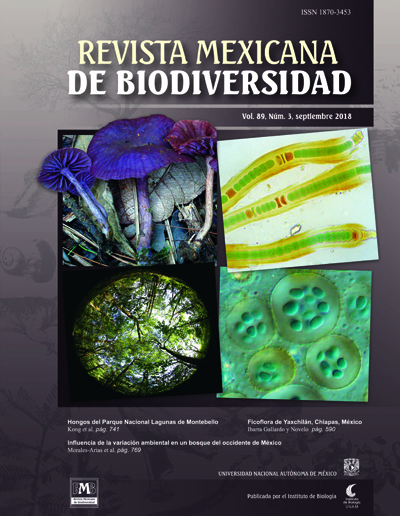Ver ítem
- xmlui.general.dspace_homeCentros e Institutos de InvestigaciónCIRN. Centro de Investigaciones de Recursos NaturalesInstituto de FloriculturaArtículos científicosxmlui.ArtifactBrowser.ItemViewer.trail
- Inicio
- Centros e Institutos de Investigación
- CIRN. Centro de Investigaciones de Recursos Naturales
- Instituto de Floricultura
- Artículos científicos
- Ver ítem
New host record of Sclerotium rolfsii causing crown and root rot on Pseudogynoxis benthamii
Resumen
Symptoms of a wilt disease were observed on 10 of 40 plants of Pseudogynoxis benthamii grown in Buenos Aires, Argentina, in March 2016. The aim of this study was to identify the causal agent of the disease. Five phenotypically identical fungal isolates were obtained from sclerotia that developed on the roots of wilted plants. One of them was inoculated onto healthy plants, and caused symptoms in 2 weeks. The pathogen was identified as Sclerotium rolfsii,
[ver mas...]
Symptoms of a wilt disease were observed on 10 of 40 plants of Pseudogynoxis benthamii grown in Buenos Aires, Argentina, in March 2016. The aim of this study was to identify the causal agent of the disease. Five phenotypically identical fungal isolates were obtained from sclerotia that developed on the roots of wilted plants. One of them was inoculated onto healthy plants, and caused symptoms in 2 weeks. The pathogen was identified as Sclerotium rolfsii, on the basis of morphological characteristics. The nuclear ribosomal DNA internal transcribed spacer region of the isolate was PCR-amplified and sequenced. DNA analysis revealed a 99-100% similarity with S. rolfsii. This is the first report of S. rolfsii causing wilt on P. benthamii and the first pathogen reported on this plant species worldwide.
[Cerrar]
En marzo de 2016, de un total de 40 plantas de Pseudogynoxis benthamii cultivadas en Buenos Aires, Argentina, se observó marchitez en 10 de ellas. El objetivo de este trabajo fue identificar el agente causal de la enfermedad. Se obtuvieron 5 aislados fúngicos de características similares a partir de esclerocios desarrollados sobre las raíces, de los cuales se seleccionó 1, que luego de ser inoculado en plantas sanas, causó síntomas en un período de 2
[ver mas...]
En marzo de 2016, de un total de 40 plantas de Pseudogynoxis benthamii cultivadas en Buenos Aires, Argentina, se observó marchitez en 10 de ellas. El objetivo de este trabajo fue identificar el agente causal de la enfermedad. Se obtuvieron 5 aislados fúngicos de características similares a partir de esclerocios desarrollados sobre las raíces, de los cuales se seleccionó 1, que luego de ser inoculado en plantas sanas, causó síntomas en un período de 2 semanas. El patógeno fue identificado como Sclerotium rolfsii sobre la base de sus características morfológicas. Se amplificó y secuenció la región de la espaciadora interna transcrita de ADN ribosomal del núcleo del aislado. El análisis de ADN
mostró 99-100% de similitud para S. rolfsii. Este es el primer reporte de S. rolfsii como agente causal de marchitez en P. benthamii y el primer patógeno citado sobre esta especie en el mundo.
[Cerrar]

Autor
Rivera, Marta Carolina;
Wright, Eduardo Roberto;
Silvestro, Luciana Belén;
Steinglein, Sebastián Alberto;
Kato, Adriana Elena;
Fuente
Revista Mexicana de Biodiversidad 89 (3) : 950-953 (2018)
Fecha
2018-03-13
Editorial
Instituto de Biología, Universidad Nacional Autónoma de México
ISSN
2007-8706
Formato
pdf
Tipo de documento
artículo
Palabras Claves
Derechos de acceso
Abierto
 Excepto donde se diga explicitamente, este item se publica bajo la siguiente descripción: Creative Commons Attribution-NonCommercial-ShareAlike 2.5 Unported (CC BY-NC-SA 2.5)
Excepto donde se diga explicitamente, este item se publica bajo la siguiente descripción: Creative Commons Attribution-NonCommercial-ShareAlike 2.5 Unported (CC BY-NC-SA 2.5)


